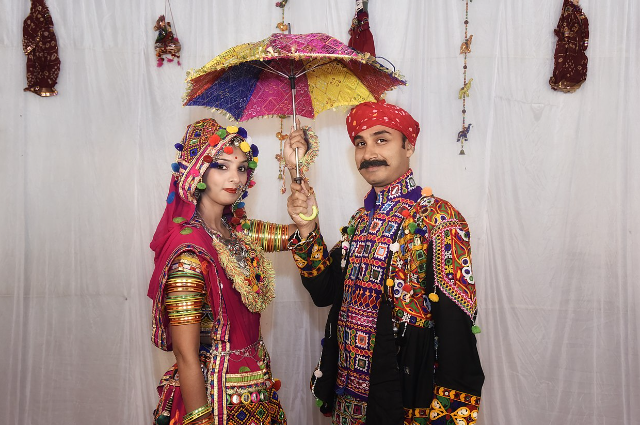
Navratri is a Hindu festival. It is celebrated all over India for nine nights. It has significance in the nine-day celebration. In Gujarat, it is called garba. Women and men are dressed in traditional dress and play garba every night by singing garba songs. Garba is popular throughout the whole country.
During all these nine days, we worship 9 different avatars of Devi Maa. Even for nine days, we wear nine different colours of traditional dress, which is also called chaniya choli in Gujarati. They dance till late at night.
In West Bengal, Navratri is known as Durga Puja. This festival is a grand celebration of Goddess Durga. Victory over Mahishasur. In West Bengal, all the temples of Maa Kali are decorated, and many different themes of pandals are also built. Each and every area has different themes of pandals. Here on the ninth day, there is a grand puja havan. And on 10 th day, the Dusshera Bengali women perform a dhunuchi dance and bid goodbye to the idol of goddess Maa Kali, which has different names.
While in South India, like Tamil Nadu, Navratri is celebrated with a tradition called Golu or Kolu. This involves the artistic display of dolls. It narrates mythological stories. In Kerala and parts of Karnataka, the last three days are dedicated to Saraswati Puja, where books and tools are worshipped.
In North India, this day is celebrated with fasting, prayers, and rituals. It celebrates Lord Rama's victory over the demon king Ravana on 10 th day, which is also called Dussehra. When Mata Sita was kidnapped, lord Rama won the battle with Ravana.
U.S, Canada, and the U.K. K where Indian, Navratri has become a way to preserve cultural heritage and promote community bonding. People get together and worship lord maa kaali.
There are nine different names of Maa Durga. And each night, Maa Durga is worshipped with different names. Maa Shailaputri, who is also known as the daughter of mountains, is the first day. She was the daughter of the Himalayas and worshipped as the goddess Durga. She is a universal mother, with innocence and stability. She rides on Nandi, holding Trishul in one hand and a lotus.
Maa Brahmacharini, who is also known as the goddess of Penance. This is the second day when Maa is worshipped. It symbolises knowledge and purity. She is the unmarried form of goddess Parvathi who married lord Shiva. She has the power to grant wisdom, self-control, and a disciplined mind.
The Bell of the Moon is the third day of the month; she is worshipped as Maa Chandraghanta. She is another avatar of the married goddess Parvathi. Her name comes from the half-moon Bell shaped on her forehead. She destroys evil and protects her devotees. She represents courage and bravery.
Maa Kushmanda is the creator of the cosmic egg. This is the fourth day of the worship. She created the universe with her divine smile. She is the source of all the energy and is associated with health, wealth, and prosperity. She rides on a lion.
Maa skandaMata who is also known as the mother of Skanda. This is the fifth day, she is the mother of lord Kartikeya, the warrior god. Worshipping her brings blessings of wisdom, prosperity, and unconditional love of a mother. She took her son on her lap and rode a lion.
Maa Katyani, the goddess of war. This goddess is worshipped on the sixth day. She is also known as Durga maa, who was born to destroy Mahishasur. She has strength, courage. She overcomes obstacles and evil forces. She rides on a lion and holds a sword.
Maa Kaalratri is another name of Durga, the destroyer of darkness. By worshipping her on the seventh day, she destroys all the negativity, including ignorance and darkness of the world. She rides on a donkey.
Maa Mahagauri, who is another name of the great white goddess who is worshipped on the eighth day.
She symbolises purity, peace, and serenity. She is a beautiful goddess who is believed to have a fair complexion. She rides on a white bull with one hand trishul and damru..
Maa Siddhidhatri, who is also known as the goddess Siddhi. This is the ninth day. She is a goddess who possesses and bestows all the types of siddhis and perfection. She is the ultimate form of Maa Durga.
By worshipping her, we get wisdom and success in every path of life. She is seated on a lotus and holds a conch shell.
On the tenth day, all Avatars of Maa Durga are worshipped with faith. This is how there are nine avatars of Maa Durga idol, and celebrated all over India in different ways.
